Summary
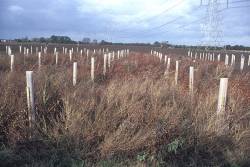 New native woodlands are often the desired objective of schemes to create new woodlands, but methods of establishment are not always predictable.
New native woodlands are often the desired objective of schemes to create new woodlands, but methods of establishment are not always predictable.
The use of innovative planting designs and species choices was suggested in Creating New Native Woodlands (PDF-92K). Establishment usually occurs by planting but the use of natural regeneration to enrich existing new plantations, or create them beside mature woodlands, has been also recommended. This process of secondary succession is well known and follows the invasion of unwooded land by tree seeds that germinate and grow to create woodland. This process of natural colonisation is little understood, unpredictable, and difficult to manage.
Experimental work has studied the following:
- Surveys of the Broadbalk and Geescroft wildernesses of Rothamsted Experimental Station
- New Native Woodland demonstration plots
- Natural colonisation of abandoned land.
Experimental results and advice are available in several publications.
New native woodlands – Broadbalk and Geescroft Wildernesses
The Broadbalk and Geescroft Wildernesses are located at Rothamsted Experimental Station. They are developed by secondary succession on farmland abandoned in the 1880s. They have both been surveyed at irregular intervals.
Broadbalk Wilderness
The Broadbalk Wilderness developed by natural colonisation following the abandonment of a small part of the large field used for the continuous wheat experiment.
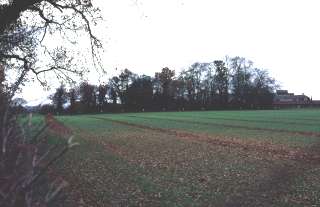 Although the Broadbalk Wilderness is well known and fairly well observed it is very small and in part barely more than a wide hedgerow (photo taken in 1996).
Although the Broadbalk Wilderness is well known and fairly well observed it is very small and in part barely more than a wide hedgerow (photo taken in 1996).
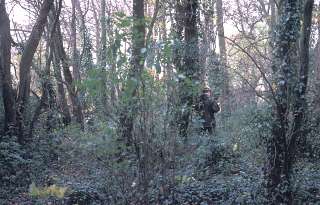 Broadbalk Wilderness is dominated by hawthorn with some oak, ash and sycamore. The trees’ canopy casts a heavy shade and the ground flora is species poor with large amounts of ivy (photo taken in 1996).
Broadbalk Wilderness is dominated by hawthorn with some oak, ash and sycamore. The trees’ canopy casts a heavy shade and the ground flora is species poor with large amounts of ivy (photo taken in 1996).
Geescroft Wilderness
The Geescroft Wilderness is a small woodland that has developed by natural colonisation following the abandonment of land on which beans had been grown more or less continuously for 30 years.
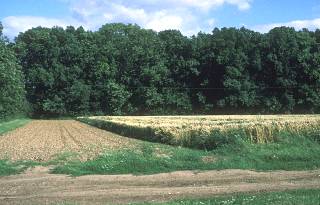 In 1998 the overstorey of Geescroft Wilderness was dominated by oak and ash with occasional wild cherry and sycamore.
In 1998 the overstorey of Geescroft Wilderness was dominated by oak and ash with occasional wild cherry and sycamore.
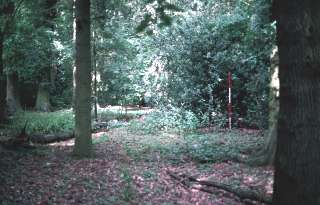 Holly dominates the understorey at Geescroft Wilderness with many impenetrable clumps throughout the woodland. The ground flora is sparse with the majority of species being distributed around the margins of the site.
Holly dominates the understorey at Geescroft Wilderness with many impenetrable clumps throughout the woodland. The ground flora is sparse with the majority of species being distributed around the margins of the site.
Useful sites
New native woodlands – Demonstration plots
New native woodland demonstration plots were set up in the National Forest in 1994 to show some of the principles described in Creating new native woodlands – Forestry Commission Bulletin 112.
The choice of species reflects those that would be expected to occur naturally on the site. At Desford the probable woodland type is an ash– field maple – dog’s mercury woodland (NVC W8) whereas at Barton–under–Needwood it is oak – bracken – bramble woodland (NVC W10).
More details are given in – Creating new native woodlands: turning ideas into reality – Forestry Commission Information Note 15.
Pictures show trees that were planted at variable spacing.
Desford
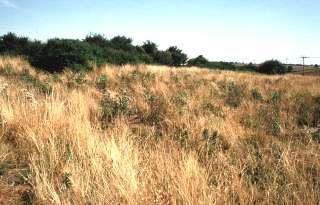 New native woodland at Desford in August 1995 towards the end of the second growing season. Weed growth was vigorous at this site and vegetation management was difficult in areas with widely spaced trees.
New native woodland at Desford in August 1995 towards the end of the second growing season. Weed growth was vigorous at this site and vegetation management was difficult in areas with widely spaced trees.
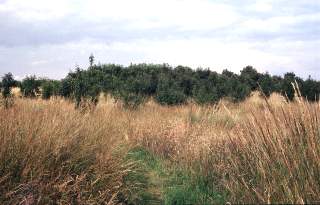 Desford in July 2001, almost 8 growing seasons after planting. The difference in the distribution of trees across the site is clearly visible. The area of dense planting has a closed canopy of trees that are several metres tall.
Desford in July 2001, almost 8 growing seasons after planting. The difference in the distribution of trees across the site is clearly visible. The area of dense planting has a closed canopy of trees that are several metres tall.
Barton–under–Needwood
 In August 1995 the young trees were beginning to emerge from the canopy of the competing ground flora.
In August 1995 the young trees were beginning to emerge from the canopy of the competing ground flora.
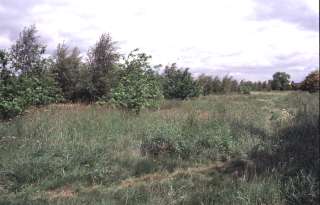 Photographed from more or less the same point in June 2001. The buildings are no longer visible and the canopy cover in areas of closely spaced trees was sufficient to suppress much of the ground flora.
Photographed from more or less the same point in June 2001. The buildings are no longer visible and the canopy cover in areas of closely spaced trees was sufficient to suppress much of the ground flora.
Useful sites
New native woodlands – Natural colonisation of abandoned land
Natural colonisation of abandoned land by secondary succession has been observed at several sites and preliminary results published in Using natural colonisation to create or expand new woodlands – Forestry Commission Information Note 23.
Aldewood
The experimental site at Aldewood was established in 1995 on poor grassland with a clay soil that was prone to waterlogging.
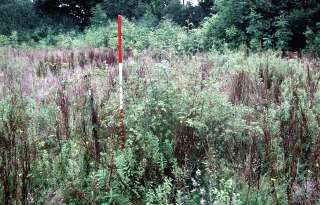 By 1999 the vegetation on site was a community of mixed herbs and grasses with occasional shrubs.
By 1999 the vegetation on site was a community of mixed herbs and grasses with occasional shrubs.
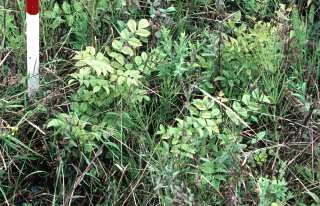 Two years after abandonment 5 tree species had invaded the site. A majority of the seedlings were ash, the largest of which were about 50 cm tall in 1999.
Two years after abandonment 5 tree species had invaded the site. A majority of the seedlings were ash, the largest of which were about 50 cm tall in 1999.
Sudbury
The site at Sudbury was established in the corner of an arable field after a crop of wheat had been harvested.
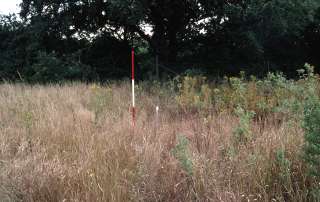 The vegetation that developed on site was influenced by the herbicides applied to control weeds. This picture shows the boundary between an untreated plot where grass dominates, and a plot treated with graminicide which has a more mixed flora.
The vegetation that developed on site was influenced by the herbicides applied to control weeds. This picture shows the boundary between an untreated plot where grass dominates, and a plot treated with graminicide which has a more mixed flora.
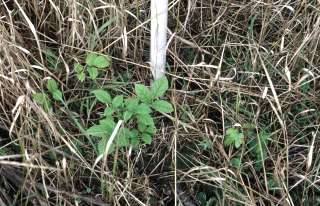 Five species of tree colonised within two years but 80% of the seedlings present were ash or field maple. Seedlings grew poorly and four years abandonment the largest seedlings were only 30 cm tall.
Five species of tree colonised within two years but 80% of the seedlings present were ash or field maple. Seedlings grew poorly and four years abandonment the largest seedlings were only 30 cm tall.
New native woodlands – Publications
Harmer, R. (2002). Creation of woodlands by natural colonisation in lowland England. In: Restocking of storm-felled forests: new approaches. Proceedings of an International Workshop in Denmark, March 2001. Ed. A. Brunner. Danish Centre for Forest, Landscape and Planning Report No. 12, Hørsholm, 109-111.
Harmer, R., Peterken, G., Kerr, G. and Poulton, P. (2001). Vegetation changes during 100 years of development of two secondary woodlands on abandoned arable land. Biological Conservation 101, 291-304.
Kerr, G., Harmer, R. and Moss, S.R. (2000). A century of vegetation change at Broadbalk Wilderness. In Long-term studies in British Woodland (ed K. J. Kirby and M. D. Morecroft) English Nature Science 34, 41-47.
Harmer, R. (1999). Creating new native woodlands: turning ideas into reality. Forestry Commission Information Note 15 (PDF-92K)
Harmer, R. (1999). Using natural colonisation to create or expand new woodlands. Forestry Commission Information Note 23 (PDF-63K)
Hodge, S. J. and Harmer, R. (1996). Woody colonisation on unmanaged urban and ex-industrial sites. Forestry 69, 245-261.
Kerr, G., Harmer, R. and Moss, S.R. (1996). Natural colonisation: a study of Broadbalk Wilderness. Aspects of Applied Biology 44, Vegetation Management in Forestry, Amenity and Conservation Areas: Managing for Multiple Objectives, 25-32.
Harmer, R. and Kerr, G. (1995). Creating woodlands: to plant trees or not? In The ecology of woodland creation. (ed. R. Ferris-Kaan) John Wiley & Sons, 113 –128.
Hodge, S.J. and Harmer, R. (1995). The creation of woodland habitats in urban and post-industrial environments. Land Contamination and Reclamation, 3, 86-88.
What’s of interest
For Forestry Commission publications:
On-line publications catalogue
